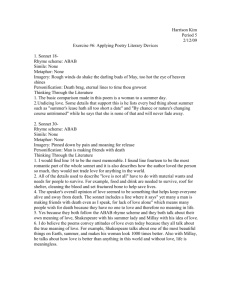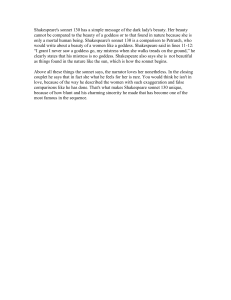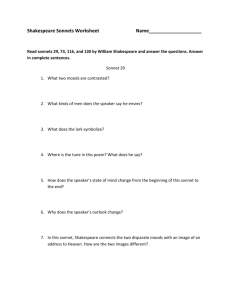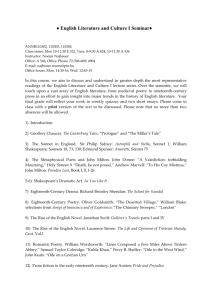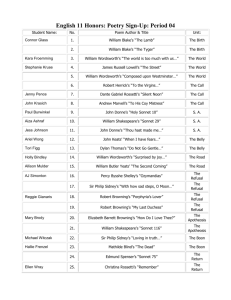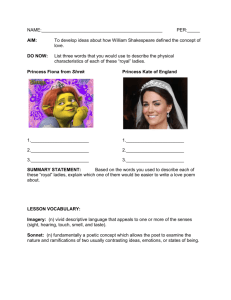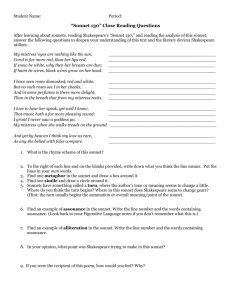Teacher Guide for FAST-R Passage
advertisement
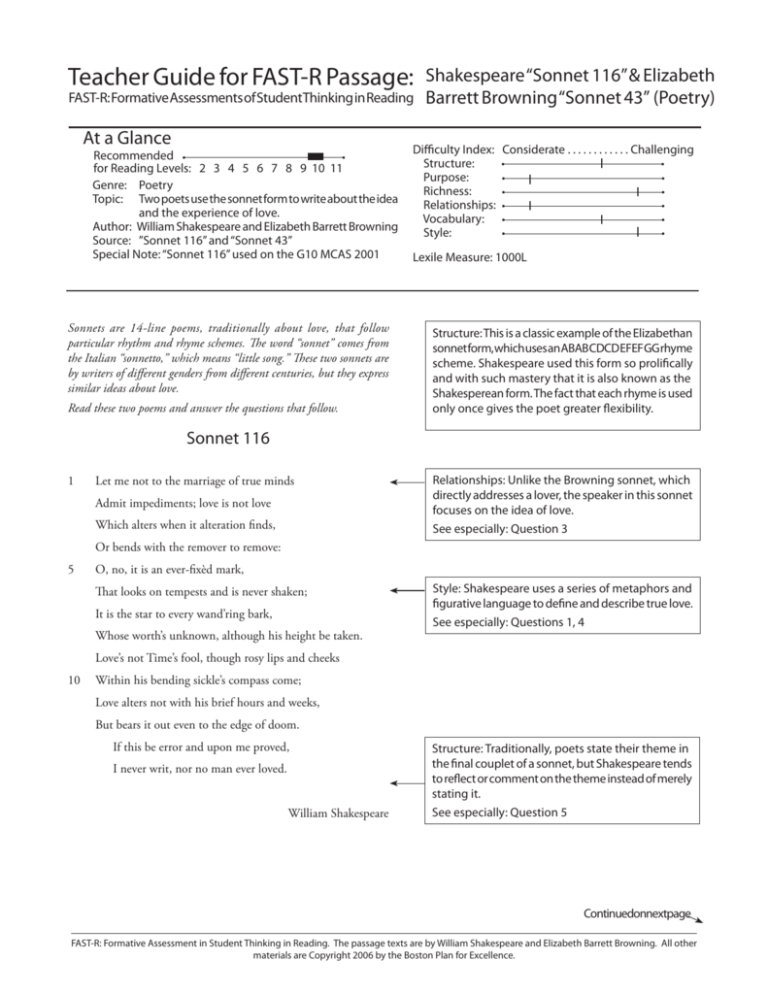
Teacher Guide for FAST-R Passage: FAST-R: Formative Assessments of StudentThinking in Reading At a Glance Recommended for Reading Levels: 2 3 4 5 6 7 8 9 10 11 Genre: Poetry Topic: Two poets use the sonnet form to write about the idea and the experience of love. Author: William Shakespeare and Elizabeth Barrett Browning Source: ”Sonnet 116” and “Sonnet 43” Special Note: “Sonnet 116” used on the G10 MCAS 2001 Sonnets are 14-line poems, traditionally about love, that follow particular rhythm and rhyme schemes. The word “sonnet” comes from the Italian “sonnetto,” which means “little song.” These two sonnets are by writers of different genders from different centuries, but they express similar ideas about love. Read these two poems and answer the questions that follow. Shakespeare “Sonnet 116” & Elizabeth Barrett Browning “Sonnet 43” (Poetry) Difficulty Index: Considerate . . . . . . . . . . . . Challenging Structure: Purpose: Richness: Relationships: Vocabulary: Style: Lexile Measure: 1000L Structure: This is a classic example of the Elizabethan sonnet form, which uses an ABAB CDCD EFEF GG rhyme scheme. Shakespeare used this form so prolifically and with such mastery that it is also known as the Shakesperean form. The fact that each rhyme is used only once gives the poet greater flexibility. Sonnet 116 1 Let me not to the marriage of true minds Admit impediments; love is not love Which alters when it alteration finds, Or bends with the remover to remove: 5 O, no, it is an ever-fixèd mark, That looks on tempests and is never shaken; It is the star to every wand’ring bark, Whose worth’s unknown, although his height be taken. Love’s not Time’s fool, though rosy lips and cheeks Relationships: Unlike the Browning sonnet, which directly addresses a lover, the speaker in this sonnet focuses on the idea of love. See especially: Question 3 Style: Shakespeare uses a series of metaphors and figurative language to define and describe true love. See especially: Questions 1, 4 10 Within his bending sickle’s compass come; Love alters not with his brief hours and weeks, But bears it out even to the edge of doom. If this be error and upon me proved, I never writ, nor no man ever loved. William Shakespeare Structure: Traditionally, poets state their theme in the final couplet of a sonnet, but Shakespeare tends to reflect or comment on the theme instead of merely stating it. See especially: Question 5 Continuedonnextpage FAST-R: Formative Assessment in Student Thinking in Reading. The passage texts are by William Shakespeare and Elizabeth Barrett Browning. All other materials are Copyright 2006 by the Boston Plan for Excellence. Sonnet 43 1 How do I love thee? Let me count the ways. I love thee to the depth and breadth and height My soul can reach, when feeling out of sight For the ends of Being and ideal Grace. 5 I love thee to the level of everyday’s Most quiet need, by sun and candle-light. I love thee freely, as men strive for Right; I love thee purely, as they turn from Praise. I love thee with the passion put to use Purpose:Todescribethefeelingsinspiredbyboundless, enduring love. See especially: Questions 7, 10 Relationships: The poem’s speaker is addressing his or her object of affection. Love, the poem implies, is sustained through both life and death. See especially: Questions 6, 8, 10 Richness:Thecomparisonsevokeothertimesofintense feeling (lines 9-10), as well as everyday constancy (lines 5-6). See especially: Question 9 10 In my old griefs, and with my childhood’s faith. I love thee with a love I seemed to lose With my lost saints!—I love thee with the breath, Smiles, tears, of all my life!—and, if God choose, I shall but love thee better after death. Style: Browning uses passionate punctuation (e.g., dashes, exclamation marks) to convey strong emotion. Structure: Browning uses a different sonnet structure than Shakespeare.This one goes: ABBA ABBA CDCD CD Elizabeth Barrett Browning Spotlight On: William Shakespeare & Elizabeth Barrett Browning WilliamShakespeare(1564-1616)iswidelyregardedasthegreatestwriterintheEnglishcanonandoneoftheworld’sbestplaywrights. Hewrote38plays,154sonnets,andmanyotherpoemsoverthecourseofhislife.Importantthemesinhissonnetsincludelove,beauty, andmortality.Hissonnets’constructionoftengivesspecialdistinctiontothebreakbetweenthe2ndand3rdquatrain.Thefinalcouplets areusually somewhat separate from the quatrains, commenting on or examining the message of the rest of the sonnet in a new way. Elizabeth Barrett Browning (1806-1861) is considered by many to be England’s greatest female poet. Her first poem was published anonymouslyatage14,anddespiteseriousillnesses,shecontinuedwritingandpublishingpoetryherentirelife.Shesecretlymarriedpoet RobertBrowningdespiteherfather’sobjections,and“Sonnet43”isfromherSonnetsfromthePortuguese,abookoflovepoemswhich shewroteduringtheirhappyfourteen-yearmarriage.Herpoemsareknownfortheirskilledandsensitiveportrayalofstrongfeelings. Ideas for Connected Writing Activities Humanities Connections •Writeastorydescribingarelationshipwhereloveisexpressed as described in “Sonnet 43.” • Choose a title for each poem and explain why the titles you havechosenareappropriate.Useevidencefromthepoem to support your points. •ResearchthelifeofElizabethBarrettBrowningtodiscoverwhen she might have written “Sonnet 43.” • Design a drawing, illustration, painting, or sculpture that embodies the ideas expressed in either poem. •ResearchShakespearetofindoutabouttherumorssurrounding the object of the affection expressed in this poem. FAST-R: Formative Assessment in Student Thinking in Reading. The passage texts are by William Shakespeare and Elizabeth Barrett Browning. All other materials are Copyright 2006 by the Boston Plan for Excellence. Teacher Guide for FAST-R Passage: FAST-R: Formative Assessments of StudentThinking in Reading Shakespeare“Sonnet116”&Elizabeth BarrettBrowning“Sonnet43”(Poetry) The annotated answer key below highlights common reasons students might choose each answer, and the sidebar gives more insight into the questions, to help you understand patterns of student responses. Always make time to follow up with students in conferences to ensure that the patterns you diagnose are consistent with students’ reading and thinking strategies. Note: You may find it helpful to refer to the “Types and Levels of Thinking Assessed on FAST-R” sheet from your teacher resource folder as you examine your students’responses. The icon in the right-hand column, below, corresponds to that sheet’s more detailed explanations of the kinds of thinking each type of question asks of readers. “Sonnet 116” by William Shakespeare 1. According to “Sonnet 116,” love is A. an impediment — (OOP2, line 1-2) students may not equate “the marriage of true minds” with “love,” or may be looking for clues surrounding the first reference to “love” in line 2 B. an ever-fixed mark — (line 5) C. a tempest — (OOP2) line 6, love “looks on tempests” but is not one D. Time’s fool — (OOP2, line 9) “Love’s not Time’s fool” FE2: Recognize the explicit meaning from varied wording in the text 2. In line 2 of “Sonnet 116,” what does the word impediments mean? A. inconsistencies — (OOP1) plausible using a “substitute in another word” strategy, since Shakespeare would not wish to “admit inconsistencies” in love B. obstacles C. impertinence — (OOB) same beginning letters and similar ending sound, but unrelated meaning D. virtues — (OOB) student may not have tested meaning in context MI1: Determine implicit meaning from words in context 3. What is the theme of “Sonnet 116”? A. True love remains steady. — can be inferred from phrases describing love as “never shaken” and “alters not” B. Even the strongest love is temporary. — (OOP2) may be plausible from students’ own experiences, but the text suggests the opposite C. Love changes as life changes. — (OOP2) text suggests the opposite D. Age and time alter love. — (OOP2)“alters,” is used in lines 3, 11 MI2: Determine a single implicit meaning from the total text 4. Based on the ideas about love expressed in “Sonnet 116,” which of the following is a metaphor with which Shakespeare might agree? A. Love is a storm that never lets up — (OOP2) contains the idea of consistency, but has a negative connotation B. Love is like a red rose. — (OOP2) familiar-sounding, but misses the concept of consistency and is a simile, not a metaphor C. Love is like an ancient tree. — (OOP1) contains the idea of consistency, but is a simile, not a metaphor D. Love is a lighthouse that shines steadily. — can be inferred from the images in the sonnet of love as steady, constant, unchanging MI4: Determine new meaning and apply it beyond the passage FAST-R: Formative Assessment in Student Thinking in Reading. The passage texts are by William Shakespeare and Elizabeth Barrett Browning. All other materials are Copyright 2006 by the Boston Plan for Excellence. Grade 10 • Poetry • “ Sonnet 116” and “Sonnet 43” 5. In the couplet at the end of “Sonnet 116”, Shakespeare asserts that, if he is proved wrong about his ideas on love, then A. he has never written a poem and nobody has ever been in love. B. he is not a writer and he has never been in love. — (OOP1) plausible read of “I never writ” but missed close read of “no man ever loved” C. he doesn’t like writing and he doesn’t like the feeling of love. — (OOB) D. he will stop writing because he can’t imagine ever being in love. — (OOP2) not plausible based on a close read of these lines FE2: Recognize the explicit meaning from varied wording in the text “Sonnet 43” by Elizabeth Barrett Browning 6. According to “Sonnet 43,” love A. can survive death. B. involves loss.— (OOP2 line 11) “lose” and “lost” appear in lines11-12 C. can consume the soul.— (OOP2 line 3) the “soul” appears, but not in the context of being consumed D. is for the young.— (OOB) nothing in the text suggests this FE2: Recognize the explicit meaning from varied wording in the text 7. The main purpose of “Sonnet 43” is to A. articulate the feelings of love. B. pay tribute to a lost lover.— (OOB) poem celebrates love without loss C. honor God.— (OOP2 line 13) “God” appears, but this is a love poem D. eulogize Grace. —(OOP2 line 4) “Grace” appears, but not as a person MI2: Determine a single implicit meaning from the total text 8. Which of the following best summarizes the idea expressed in lines 2-4 of “Sonnet 43”? A. Love is out of sight.— (OOP1) this phrase appears in line 3, but students must recognize that the colloquial “out of sight” (meaning “great”) does not fit the tone of the poem or time of the author B. Love is at an end.— (OOP2) students may think “the soul” is finite C. Love is boundless. D. Love is wonderful.— (OOB) Browning generally seems to think so, but it’s not the idea expressed in these lines MI2: Determine a single implicit meaning from the total of a particular set of lines 9. Which of the following best paraphrases lines 5-6 of “Sonnet 43”? A. “I need to love you.” — (OOP2 line 6) the word “need” appears B. “I love you to the sky and back.”— (OOB) C. “I love you quietly and passionately.” — (OOP1) the speaker may feel this way, but it’s not the best paraphrase of these lines D. “I love you every moment of the day and night.” FE2: Recognize the explicit meaning from varied wording in the text 10. In both sonnets, love is portrayed as A. selfish and childish. — (OOP2 “Sonnet 43” line 10) B. timeless and enduring. C. dangerous.— (OOB) D. stormy and stubborn. — (OOP2 “Sonnet 116” line 6) MI2: Determine a single implicit meaning from the total texts FAST-R: Formative Assessment in Student Thinking in Reading. The passage texts are by William Shakespeare and Elizabeth Barrett Browning. All other materials are Copyright 2006 by the Boston Plan for Excellence. FAST-R + Formative Assessments of Student Thinking in Reading Name Shakespeare “Sonnet 116” and “Browning “Sonnet 43” • Poetry Date Teacher/Class Sonnets are 14-line poems, traditionally about love, that follow particular rhythm and rhyme schemes. The word “sonnet” comes from the Italian “sonnetto,” which means “little song.” These two sonnets are by writers of different genders from different centuries, but they express similar ideas about love. Read these two poems and answer the questions that follow. Sonnet 43 Sonnet 116 1 Let me not to the marriage of true minds 1 How do I love thee? Let me count the ways. Admit impediments; love is not love I love thee to the depth and breadth and height Which alters when it alteration finds, My soul can reach, when feeling out of sight Or bends with the remover to remove: For the ends of Being and ideal Grace. 5 O, no, it is an ever-fixèd mark, 5 I love thee to the level of everyday’s That looks on tempests and is never shaken; Most quiet need, by sun and candle-light. It is the star to every wand’ring bark, I love thee freely, as men strive for Right; Whose worth’s unknown, although his height be taken. Love’s not Time’s fool, though rosy lips and cheeks I love thee purely, as they turn from Praise. I love thee with the passion put to use 10 Within his bending sickle’s compass come; 10 In my old griefs, and with my childhood’s faith. Love alters not with his brief hours and weeks, I love thee with a love I seemed to lose But bears it out even to the edge of doom. With my lost saints!—I love thee with the breath, If this be error and upon me proved, Smiles, tears, of all my life!—and, if God choose, I never writ, nor no man ever loved. I shall but love thee better after death. — Elizabeth Barrett Browning — William Shakespeare Spotlight On: William Shakespeare & Elizabeth Barrett Browning William Shakespeare (1564-1616) is widely regarded as one of the greatest writers in the English canon and one of the world’s best playwrights. He wrote 38 plays, 154 sonnets, and many other poems over the course of his life. Important themes in his sonnets include love, beauty, and mortality. His sonnets’ construction often gives special distinction to the break between the 2nd and 3rd quatrain. The final couplets are usually somewhat separate from the quatrains, commenting on or examining the message of the rest of the sonnet in a new way. Elizabeth Barrett Browning (1806-1861) is considered by many to be England’s greatest female poet. Her first poem was published anonymously at age 14, and despite serious illnesses, she continued writing and publishing poetry her entire life. She secretly married poet Robert Browning despite her father’s objections, and “Sonnet 43” is from her Sonnets from the Portuguese, a book of love poems which she wrote during their happy fourteen-year marriage. Her poems are known for their skilled and sensitive portrayal of strong feelings. FAST-R: The Formative Assessments of Student Thinking in Reading. The passage texts are by William Shakespeare & Elizabeth Barrett Browning. All other materials are Copyright 2007 by the Boston Plan for Excellence. FAST-R + Formative Assessments of Student Thinking in Reading Name Date Shakespeare “Sonnet 116” & Browning “Sonnet 43” • Poetry Teacher/Class Directions: On your answer sheet, fill in the circle for the correct answer. “Sonnet 116” by William Shakespeare 1. According to “Sonnet 116,” love is A. an impediment B. an ever-fixed mark C. a tempest D. Time’s fool 2. In line 2 of “Sonnet 116,” what does the word impediments mean? A. inconsistencies B. obstacles C. impertinence D. virtues 3. What is the theme of “Sonnet 116”? A. True love remains steady. B. Even the strongest love is temporary. C. Love changes as life changes. D. Age and time alter love. 4. Based on the ideas about love expressed in “Sonnet 116,” which of the following is a metaphor with which Shakespeare might agree? A. Love is a storm that never lets up. B. Love is like a red rose. C. Love is like an ancient tree. D. Love is a lighthouse that shines steadily. 5. In the couplet at the end of “Sonnet 116,” Shakespeare asserts that, if he is proved wrong about his ideas on love, then A. he has never written a poem and nobody has ever been in love. B. he is not a writer and he has never been in love. C. he doesn’t like writing and he doesn’t like the feeling of love. D. he will stop writing because he can’t imagine ever being in love. Continued on next page FAST-R: The Formative Assessments of Student Thinking in Reading. The passage texts are by William Shakespeare & Elizabeth Barrett Browning. All other materials are Copyright 2007 by the Boston Plan for Excellence. Name School Date Teacher/Class “Sonnet 43” by Elizabeth Barrett Browning 6. According to “Sonnet 43,” love A. can survive death. B. involves loss. C. can consume the soul. D. is for the young. 7. The main purpose of “Sonnet 43” is to A. articulate the feelings of love. B. pay tribute to a lost lover. C. honor God. D. eulogize Grace. 8. Which of the following best summarizes the idea expressed in lines 2-4 of “Sonnet 43”? A. Love is out of sight. B. Love is at an end. C. Love is boundless. D. Love is wonderful. 9. Which of the following best paraphrases lines 5-6 of “Sonnet 43”? A. “I need to love you.” B. “I love you to the sky and back.” C. “I love you quietly and passionately.” D. “I love you every moment of the day and night.” 10. In both sonnets, love is portrayed as A. selfish and childish. B. timeless and enduring. C. dangerous. D. stormy and stubborn. FAST-R: The Formative Assessments of Student Thinking in Reading. The passage texts are by William Shakespeare & Elizabeth Barrett Browning. All other materials are Copyright 2007 by the Boston Plan for Excellence. Teachers: Please duplicate and use this answer sheet only for students for whom you did not receive a pre-printed answer sheet! FAST-R Answer Sheet Name School Date Grade Passage Title Teacher Name Completely fill the circle for the correct answer. 1. A B C D 2. A B C D 3. A B C D 4. A B C D 5. A B C D 6. A B C D 7. A B C D 8. A B C D 9. A B C D 10. A B C D Class Write your answer to the open response prompt in the lined space below. if your teacher directs you to do so. OFFICE USE ONLY RESEARCH: Y N OPEN RESPONSE: 1 2 3 4

